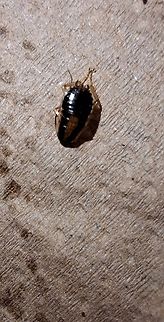
Appearance
Although "B. germanica" has wings, it can barely fly, although it may glide when disturbed. Of the few species of cockroach that are domestic pests, it probably is the most widely troublesome example. It is very closely related to the Asian cockroach, and to the casual observer, the two appear nearly identical and may be mistaken for each other.Behavior
The German cockroach occurs widely in human buildings, but is particularly associated with restaurants, food processing facilities, hotels, and institutional establishments such as nursing homes and hospitals. They can survive outside as well, though they are not commonly found in the wild. In cold climates, they occur only near human dwellings, because they cannot survive severe cold. However, German cockroaches have been found as inquilines of human buildings as far north as Alert, Nunavut. Similarly, they have been found as far south as southern Patagonia.Though nocturnal, the German cockroach occasionally appears by day, especially if the population is crowded or has been disturbed. However, sightings are most frequent in the evening, when someone suddenly brings a light into a room deserted after dark, such as a kitchen where they have been scavenging. When excited or frightened, the species emits an unpleasant odor.
Reproduction
The German cockroach reproduces faster than any other residential cockroach, growing from egg to reproductive adult in roughly 50 – 60 days under ideal conditions.Females are rounder and shorter in contrast to males which tend to be longer, narrower and of lighter color. Once fertilized, a female German cockroach develops an ootheca in her abdomen. The abdomen swells as her eggs develop, until the translucent tip of the ootheca begins to protrude from the end of her abdomen, and by that time the eggs inside are fully sized, about 1/4 inch long with 16 segments.
The ootheca, at first translucent, soon turns white and then within a few hours turns pink, progressively darkening until, some 48 hours later, it attains the dark red-brown of the shell of a chestnut. It has a keel-like ridge along the line where the young emerge, and curls slightly towards that edge as it completes its maturation. A small percentage of the nymphs may hatch while the ootheca is still attached to the female, but the majority emerge some 24 hours after it has detached from the female's body. The newly hatched 3-mm-long black nymphs then progress through six or seven instars before becoming sexually mature, but ecdysis is such a hazardous process that nearly half the nymphs die of natural causes before reaching adulthood. Molted skins and dead nymphs are soon eaten by living nymphs present at the time of molting.
Food
German cockroaches are omnivorous scavengers. They are attracted particularly to meats, starches, sugars, and fatty foods. Where a shortage of foodstuff exists, they may eat household items such as soap, glue, and toothpaste. In famine conditions, they turn cannibalistic, chewing at each other's wings and legs. The German cockroach is an intermediate host of the Acanthocephalan parasite "Moniliformis kalahariensis".Evolution
Previously thought to be a native of Europe, the German cockroach later was considered to have emerged from the region of Ethiopia in Northeast Africa, but recent evidence indicates that it actually originated in South Asia or Southeast Asia, and diverged from "Blattella asahinai" slightly over 2000 years ago. The cockroach's sensitivity to cold might reflect its origin from such warm climates, and its spread as a domiciliary pest since ancient times has resulted from incidental human transport and shelter. The species now is cosmopolitan in distribution, occurring as a household pest on all continents except Antarctica, and on many major islands, as well. It accordingly has been given various names in the cultures of many regions.References:
Some text fragments are auto parsed from Wikipedia.